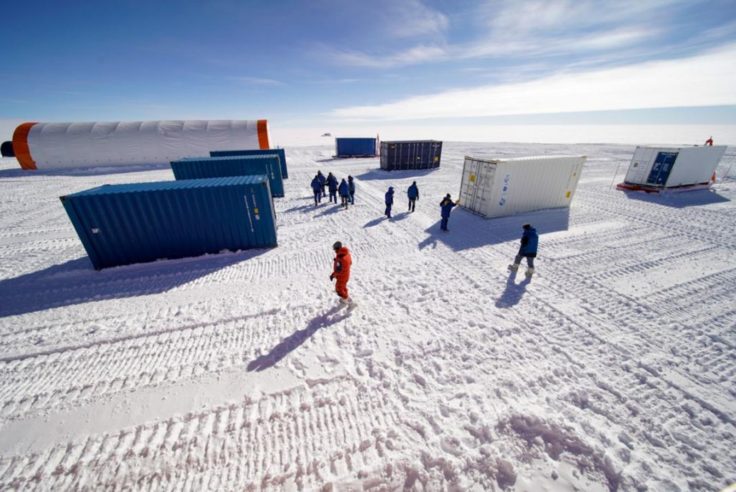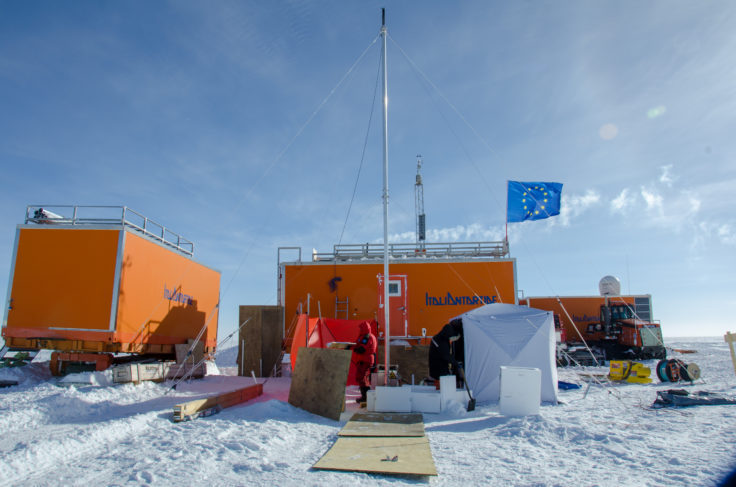Mission to drill Antarctica’s oldest ice
The first campaign to drill Antarctica’s oldest ice starts this month (November). Beyond EPICA-Oldest Ice aims to drill an ice core to collect a record of past climate spanning 1.5 million years. Scientists hope this record can help them explain why Earth’s ice ages flipped in frequency in the deep past.
Beyond Epica-Oldest Ice is funded by the European Commission with 11 million euros and it is coordinated by the Institute of Polar Sciences of the Cnr (National Research Council of Italy). British Antarctic Survey is the UK partner.
The project, which started in 2019, will last seven years. This first drilling campaign, which will last until January 2022, will be conducted at Little Dome C, an area of 10 km2, located 40 km from the Italian-French Concordia Station, on the east Antarctic plateau — one of the most extreme places on the Earth.
Glaciologists, engineers and technicians of the international team will work at an altitude of 3,233 metres above sea level, over 1,000 km away from the coast, and will experience average Antarctic summer temperatures of -35°C.
Once field camp installation is complete at Little Dome C, making the drilling site fully operational, the drilling system will be tested. While doing this, the team will also complete the construction of a temporary storage cave in the snow that will protect the first ice samples. The success of this campaign is crucial to the outcome of the entire project. There will be two decisive moments for the history of climate science: the first, will be drilling the pilot hole from which the ice core will be extracted; the second, will be the extraction of the first layers of ice by the end of this campaign. The team hopes to achieve an average coring rate of 170 m per week.
“During our previous EPICA (European Project for Ice Coring in Antarctica) project, which ended in 2008, we managed to extract and analyse an 800,000-year-old ice core. Now we are trying to travel back further in time: because if we are to gain a correct perspective on what the world is currently experiencing with climate change, and adopt suitable mitigating strategies, we must look back even further — which is what we are trying to do in Antarctica with Beyond EPICA,” says lead scientist Carlo Barbante, director of the Institute of Polar Sciences of the National Research Council of Italy (Cnr-Isp) and professor at Ca’ Foscari University of Venice, who is involved on site in the campaign.

The climate and the environmental history of our planet is archived in the ice: it can reveal information from centuries and even hundreds of millennia ago on the evolution of temperature and on the composition of the atmosphere. Researchers will therefore be able to assess the content of greenhouse gases, such as methane and carbon dioxide, in the atmosphere of the past. Then, they will be able to link these findings with the evolution of temperature.
Over two field seasons in 2016/17 and 2017/18, Dr Robert Mulvaney an ice coring scientist from British Antarctic Survey was involved in surveying the area around Little Dome C for the best drill site. He says:
“Finally, after several years spent searching for the best site for the drilling, and a delayed start due to Covid restrictions, we are finally getting underway drilling for the Oldest Ice core at Little Dome C this year. BAS contributed its DELORES radar to the search for the ideal site, collecting over 2400 km of over-snow radar to characterise the bedrock topography and the age structure of the ice. Time will tell whether we have chosen well, and it may take us four years to drill to the bed, but I am confident that we will recover ice substantially older than the 800000 years record previously retrieved from Dome C itself, 35 km distant from the new site.”

The other scientists on site will be Thomas Stocker, Remo Walther, and Jakob Schwander from the University of Bern. The drillers will be Philippe Possenti, Gregory Teste, Olivier Alemany, and Romain Duphil of the University of Grenoble-Alpes, and Matthias Hüther of the Alfred Wegener Institute. Logistics and telecommunications will be managed by Michele Scalet, Saverio Panichi, Giacomo Bonanno of Enea and Calogero Monaco of the Genio Guastatori regiment.